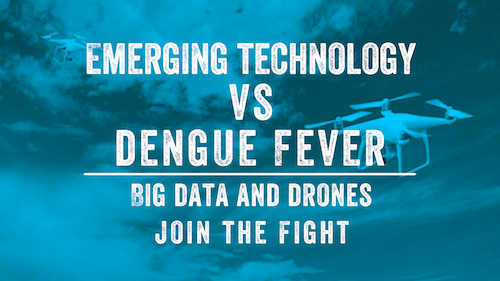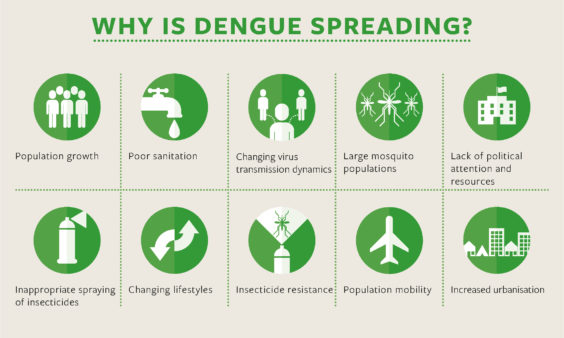- by Alison
Emerging technology combating dengue: Big data and drones join the fight

We recently looked at Artificial Intelligence predicting dengue alongside and how smart machines are being employed to help control outbreaks of this disease. However, there are other emerging technologies are also becoming increasingly important in the fight – including big data and drones. Let’s take a look at some initiatives using emerging technology to fight dengue.
Big data versus dengue
Big data, in a nutshell, is a term for large and complex sets of data – generally gathered from a combination of different sources – that are too much for traditional data-processing software to analyze. Big data is important because it can help you solve problems you wouldn’t have been able to tackle before, thanks to the unique understanding or near real-time insights that specialist ‘advanced analytics’ software can provide.
The greater the volume and variety of data, the more accurate the insights because the diversity of the data sources helps to correct any errors in any individual source. Our own Dengue Track initiative, for instance, combines official data, the results of internet queries, social media messages, crowd-sourced surveillance and data from diagnostics. By analyzing these together, Dengue track not only informs health authorities of impending risks but also lets individuals know when they are at risk.
Click to sign the petition for a World Dengue Day
Other initiatives use a wide variety of structured and unstructured sources, from traditional data sources such as climatic factors and population density to modern social media posts and mobile phone records:
• In 2014, researchers at the Harvard T.H. Chan School of Public Health (HSPH) in Boston combined phone records of around 40 million Pakistani subscribers (representing 22 percent of the country’s population) with climate data to predict the spread of dengue. They matched the trajectory of the dengue virus in the 2013 epidemic to the traveling pattern of mobile users and found that mobile tracking could fairly accurately predict instances of dengue.
• In the same year, a team comprising Malaysia’s Teradata, Multimedia University (MMU) and Ministry of Health won the Big Data App challenge with a dengue prediction index. They combined atmospheric, altitude, construction, weather (rainfall, wind velocity and direction, min/max temperature and solar radiation, humidity, and thunderstorms) with dengue statistics for their index for Malaysia. The index predicted outbreaks with 80 percent success rate, which decreased dengue-related deaths by 40 percent from 2016 to 2017.
• A big data project by the Software Engineering Research Group at Paulista University in Brazil uses data gleaned from social networks, text mining, and machine learning to identify patterns in dengue outbreaks and, from that, probable dengue outbreaks in a particular region of Brazil. It showed that combining this unstructured data with structured data from traditional sources could help predict future behaviors and, thus, help with prevention.
• A big data analytics study by the Department of Information System at the Universiti Tenaga Nasional in Malaysia proposed big data analytics modeling techniques to determine and predict how long dengue patients would be hospitalized. Its finding may improve resource planning and assist with expectations around patients’ length of stay.
• The European Commission is running a competition to build an early warning system for epidemics. Applicants are invited to demonstrate a “reliable, cost-effective and scalable early warning system prototype to forecast and monitor vector-borne diseases” by integrating big data from a variety of sources. The competition opened in April and runs until September 2020.
Drones versus dengue
Drone is a common name for an unmanned aerial vehicle or UAV. It’s a small aircraft that flies without a human pilot on board; instead, a ground-based controller flies it using a two-way communications system.
Engineers are using drones with cameras on board to inspect places that are either hazardous or difficult to reach. This saves a great deal of time and expense, allowing places that would not otherwise be inspected to be checked out – as in the following examples:

Image courtesy of Malaria Consortium
• If tests show the quality of images to be satisfactory, Siliguri in West Bengal will use a drone to take pictures of stagnant water on terraces of buildings. It will, hopefully, help identify where dengue larvae need to be eliminated from high-rise buildings.
• Also in West Bengal, Kolkata is also planning to use drones to identify Aedes aegypti breeding grounds. While it will mainly survey the rooftops of high-rise buildings (including those under construction), it will also look at bridges and flyovers.
• In Guatemala, public authorities are deploying drones to collect aerial images of potential breeding sites near rural villages, including cisterns, pots and buckets, old tires, flower pots, and unused fountains. These images will be analyzed to target larvicide applications. The collaboration with the Universidad del Valle de Guatemala will monitor public perception of the use of this technology.
• A similar project in Trinamul in West Bengal encountered resistance, with people concerned about privacy – for both individuals and important establishments. Some councilors opposed to their use have questioned whether permission is needed to fly the drones.
Future drone use:
• Officials in Placer County in California are planning to experiment with using the drones to apply larvicide this summer, after successfully using the technology to photograph larvae in standing water.
• A joint UNICEF and Vanuatu project plans to use drones to deliver vaccines along with the nation’s chain of 83 tiny, remote volcanic islands, which span a 1600 km atoll. Currently, nine-seater puddle-jumper planes hop from island to island, landing on grass airstrips in an approach that is slow and inefficient, and frequently faces delays.
Emerging technologies continue to add to the toolbox as we step up the fight against dengue. Share your stories of how you are turning to modern technologies in your own battle against the disease.
—
Help us map dengue so that experts better understand this disease. Click below to report dengue activity near you to Dengue Track.

